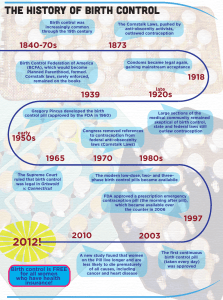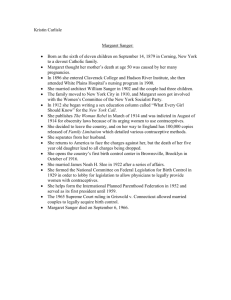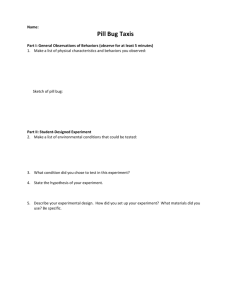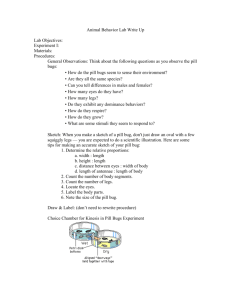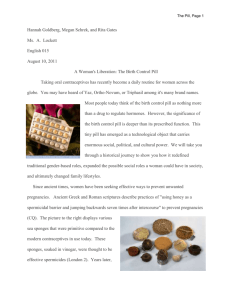Moments in the History of Birth Control short timeline
advertisement
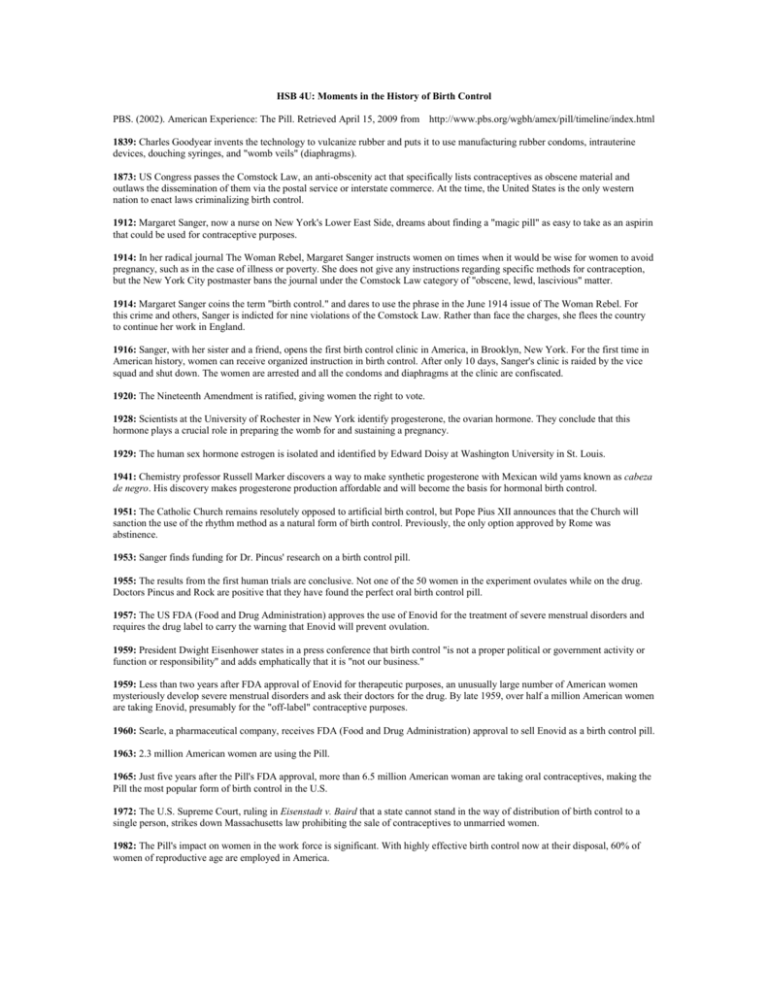
HSB 4U: Moments in the History of Birth Control PBS. (2002). American Experience: The Pill. Retrieved April 15, 2009 from http://www.pbs.org/wgbh/amex/pill/timeline/index.html 1839: Charles Goodyear invents the technology to vulcanize rubber and puts it to use manufacturing rubber condoms, intrauterine devices, douching syringes, and "womb veils" (diaphragms). 1873: US Congress passes the Comstock Law, an anti-obscenity act that specifically lists contraceptives as obscene material and outlaws the dissemination of them via the postal service or interstate commerce. At the time, the United States is the only western nation to enact laws criminalizing birth control. 1912: Margaret Sanger, now a nurse on New York's Lower East Side, dreams about finding a "magic pill" as easy to take as an aspirin that could be used for contraceptive purposes. 1914: In her radical journal The Woman Rebel, Margaret Sanger instructs women on times when it would be wise for women to avoid pregnancy, such as in the case of illness or poverty. She does not give any instructions regarding specific methods for contraception, but the New York City postmaster bans the journal under the Comstock Law category of "obscene, lewd, lascivious" matter. 1914: Margaret Sanger coins the term "birth control." and dares to use the phrase in the June 1914 issue of The Woman Rebel. For this crime and others, Sanger is indicted for nine violations of the Comstock Law. Rather than face the charges, she flees the country to continue her work in England. 1916: Sanger, with her sister and a friend, opens the first birth control clinic in America, in Brooklyn, New York. For the first time in American history, women can receive organized instruction in birth control. After only 10 days, Sanger's clinic is raided by the vice squad and shut down. The women are arrested and all the condoms and diaphragms at the clinic are confiscated. 1920: The Nineteenth Amendment is ratified, giving women the right to vote. 1928: Scientists at the University of Rochester in New York identify progesterone, the ovarian hormone. They conclude that this hormone plays a crucial role in preparing the womb for and sustaining a pregnancy. 1929: The human sex hormone estrogen is isolated and identified by Edward Doisy at Washington University in St. Louis. 1941: Chemistry professor Russell Marker discovers a way to make synthetic progesterone with Mexican wild yams known as cabeza de negro. His discovery makes progesterone production affordable and will become the basis for hormonal birth control. 1951: The Catholic Church remains resolutely opposed to artificial birth control, but Pope Pius XII announces that the Church will sanction the use of the rhythm method as a natural form of birth control. Previously, the only option approved by Rome was abstinence. 1953: Sanger finds funding for Dr. Pincus' research on a birth control pill. 1955: The results from the first human trials are conclusive. Not one of the 50 women in the experiment ovulates while on the drug. Doctors Pincus and Rock are positive that they have found the perfect oral birth control pill. 1957: The US FDA (Food and Drug Administration) approves the use of Enovid for the treatment of severe menstrual disorders and requires the drug label to carry the warning that Enovid will prevent ovulation. 1959: President Dwight Eisenhower states in a press conference that birth control "is not a proper political or government activity or function or responsibility" and adds emphatically that it is "not our business." 1959: Less than two years after FDA approval of Enovid for therapeutic purposes, an unusually large number of American women mysteriously develop severe menstrual disorders and ask their doctors for the drug. By late 1959, over half a million American women are taking Enovid, presumably for the "off-label" contraceptive purposes. 1960: Searle, a pharmaceutical company, receives FDA (Food and Drug Administration) approval to sell Enovid as a birth control pill. 1963: 2.3 million American women are using the Pill. 1965: Just five years after the Pill's FDA approval, more than 6.5 million American woman are taking oral contraceptives, making the Pill the most popular form of birth control in the U.S. 1972: The U.S. Supreme Court, ruling in Eisenstadt v. Baird that a state cannot stand in the way of distribution of birth control to a single person, strikes down Massachusetts law prohibiting the sale of contraceptives to unmarried women. 1982: The Pill's impact on women in the work force is significant. With highly effective birth control now at their disposal, 60% of women of reproductive age are employed in America.
